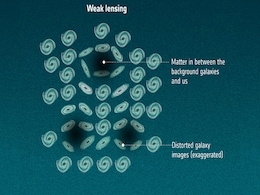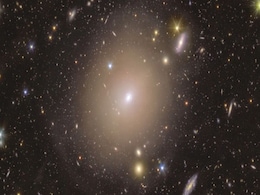Cosmic Study
- All
- News
- Videos
-

NASA’s SPHEREx Mission Sends First Space Images Before Full Sky Survey
- Thursday April 3, 2025
- Written by Gadgets 360 Staff
NASA’s SPHEREx telescope has captured its first images from space, marking a critical milestone before its full-sky infrared survey begins. The observatory, launched on March 11, recorded thousands of light sources, including distant galaxies and stars. Unlike other space telescopes, SPHEREx is designed for large-scale cosmic mapping, scanning th...
-
 www.gadgets360.com
www.gadgets360.com
-

Did Black Hole Radiation Shape the Universe?
- Saturday March 29, 2025
- Written by Gadgets 360 Staff
A study suggests that Hawking radiation, first proposed by Stephen Hawking, may have influenced the universe’s structure. According to reports, primordial black holes that existed in the early universe could have evaporated through Hawking radiation, impacting matter distribution. The research explores how these black holes might have shaped gala...
-
 www.gadgets360.com
www.gadgets360.com
-

Wolf-Rayet 104's Orbit Tilt Reduces Gamma-Ray Burst Threat, Study Finds
- Thursday March 20, 2025
- Written by Gadgets 360 Staff
New research using Keck Observatory’s instruments confirms that the orbit of Wolf-Rayet 104 is tilted 30-40 degrees away from Earth, lowering concerns about a possible gamma-ray burst. Previously, it was believed that the system’s alignment could pose a risk. However, spectroscopy data now challenges these assumptions, raising new questions abo...
-
 www.gadgets360.com
www.gadgets360.com
-

Smallest Galaxy Ever Found: Andromeda XXXV Defies Cosmic Evolution Models
- Thursday March 13, 2025
- Written by Gadgets 360 Staff
Astronomers have discovered Andromeda XXXV, the smallest and faintest known galaxy, located 3 million light-years away. It challenges existing models of galaxy formation, as similar small galaxies were thought to be destroyed in the early universe. Researchers are studying how it retained conditions for star formation despite harsh cosmic environme...
-
 www.gadgets360.com
www.gadgets360.com
-

Water May Have Formed in the Universe 100 Million Years After Big Bang
- Thursday March 13, 2025
- Written by Gadgets 360 Staff
A new study suggests water formed in the universe just 100–200 million years after the Big Bang, much earlier than previously estimated. Researchers examined ancient supernovas to understand how oxygen combined with hydrogen to create water. If confirmed, these findings could change perspectives on when the conditions for life first emerged. The ...
-
 www.gadgets360.com
www.gadgets360.com
-

Black Hole Singularities May Not Exist, Say Scientists
- Friday March 7, 2025
- Written by Gadgets 360 Staff
A new study questions the existence of black hole singularities, suggesting refinements to Einstein’s equations using quantum gravity concepts. Researchers argue that infinite density points may not be real, replacing them with highly curved but finite regions of space-time. While direct observation remains difficult, gravitational waves and earl...
-
 www.gadgets360.com
www.gadgets360.com
-

NASA’s New Missions Will Map the Sun and the Cosmos
- Tuesday March 4, 2025
- Written by Gadgets 360 Staff
NASA is set to launch two major missions, PUNCH and SPHEREx, aboard a SpaceX Falcon 9 from Vandenberg Space Force Base on March 2. PUNCH, a four-satellite system, will study the sun’s corona and space weather, while SPHEREx will create infrared maps of the cosmos to study galaxy evolution and cosmic history. These missions will contribute to a de...
-
 www.gadgets360.com
www.gadgets360.com
-

Solar System’s Journey Through Orion Complex May Have Altered Earth’s Climate
- Monday March 3, 2025
- Written by Gadgets 360 Staff
Scientists have studied the solar system’s passage through the Orion complex, a dense region in space, around 14 million years ago. According to researchers, this movement may have compressed the heliosphere and increased interstellar dust reaching Earth. This dust could have influenced the planet’s climate and left traces in geological records...
-
 www.gadgets360.com
www.gadgets360.com
-

NASA’s SPHEREx Telescope Launching Aboard SpaceX Falcon 9 to Explore Cosmic Evolution
- Friday February 28, 2025
- Written by Gadgets 360 Staff
NASA’s SPHEREx telescope, launching on Feb 28 aboard a SpaceX Falcon 9, will map the entire sky in infrared, observing 450 million galaxies and 100 million Milky Way stars. The mission aims to uncover the large-scale structure of the universe, track icy molecules in interstellar space, and study cosmic inflation. Equipped with a spectrophotometer...
-
 www.gadgets360.com
www.gadgets360.com
-

Hubble Captures Stunning Tarantula Nebula Image, Revealing Cosmic Dust and Star Formation
- Thursday February 27, 2025
- Written by Gadgets 360 Staff
A new image from the Hubble Space Telescope highlights the Tarantula Nebula’s complex structure, featuring dense cosmic dust clouds and vibrant star-forming regions. This nebula, located 160,000 light-years away, plays a vital role in understanding stellar evolution. The captured details offer insights into how cosmic dust contributes to star and...
-
 www.gadgets360.com
www.gadgets360.com
-

Hubble’s New Image of Tarantula Nebula Showcases Cosmic Dust and Star Formation
- Tuesday February 18, 2025
- Written by Gadgets 360 Staff
NASA/ESA’s Hubble Space Telescope has captured a breathtaking image of the Tarantula Nebula, located 160,000 light-years away in the Large Magellanic Cloud. The image reveals intricate cosmic dust patterns and active star formation, offering valuable insights into the role of interstellar material in stellar evolution. Researchers are using the d...
-
 www.gadgets360.com
www.gadgets360.com
-

Weak Gravitational Lensing Examines Universe’s Structure: What You Need to Know
- Thursday February 13, 2025
- Written by Gadgets 360 Staff
The universe's large-scale uniformity is under scrutiny through weak gravitational lensing. Researchers are analysing data from the Euclid Space Telescope to detect potential anisotropies in cosmic expansion. If confirmed, these findings could challenge the fundamental Cosmological Principle, which assumes the universe has no preferred direction. T...
-
 www.gadgets360.com
www.gadgets360.com
-

Euclid Space Telescope Discovers Rare Einstein Ring, Revealing Dark Matter Secrets
- Wednesday February 12, 2025
- Written by Gadgets 360 Staff
The Euclid space telescope has detected a rare Einstein ring around galaxy NGC 6505, located approximately 590 million light-years from Earth. This phenomenon, resulting from gravitational lensing, allows scientists to study the distribution of dark matter within the lensing galaxy. The discovery aligns with Euclid's mission to map cosmic structure...
-
 www.gadgets360.com
www.gadgets360.com
-

Hubble Spots Distant Supernova in Gemini, Enhancing Cosmic Distance Studies
- Tuesday February 4, 2025
- Written by Gadgets 360 Staff
The NASA/ESA Hubble Space Telescope has captured a stunning image of SN 2022aajn, a Type Ia supernova in the constellation Gemini. Located 600 million light-years away, the explosion was first detected in November 2022. Type Ia supernovae serve as essential cosmic distance markers due to their predictable brightness. Hubble’s observations, part o...
-
 www.gadgets360.com
www.gadgets360.com
-

NASA’s SPHEREx Mission Sends First Space Images Before Full Sky Survey
- Thursday April 3, 2025
- Written by Gadgets 360 Staff
NASA’s SPHEREx telescope has captured its first images from space, marking a critical milestone before its full-sky infrared survey begins. The observatory, launched on March 11, recorded thousands of light sources, including distant galaxies and stars. Unlike other space telescopes, SPHEREx is designed for large-scale cosmic mapping, scanning th...
-
 www.gadgets360.com
www.gadgets360.com
-

Did Black Hole Radiation Shape the Universe?
- Saturday March 29, 2025
- Written by Gadgets 360 Staff
A study suggests that Hawking radiation, first proposed by Stephen Hawking, may have influenced the universe’s structure. According to reports, primordial black holes that existed in the early universe could have evaporated through Hawking radiation, impacting matter distribution. The research explores how these black holes might have shaped gala...
-
 www.gadgets360.com
www.gadgets360.com
-

Wolf-Rayet 104's Orbit Tilt Reduces Gamma-Ray Burst Threat, Study Finds
- Thursday March 20, 2025
- Written by Gadgets 360 Staff
New research using Keck Observatory’s instruments confirms that the orbit of Wolf-Rayet 104 is tilted 30-40 degrees away from Earth, lowering concerns about a possible gamma-ray burst. Previously, it was believed that the system’s alignment could pose a risk. However, spectroscopy data now challenges these assumptions, raising new questions abo...
-
 www.gadgets360.com
www.gadgets360.com
-

Smallest Galaxy Ever Found: Andromeda XXXV Defies Cosmic Evolution Models
- Thursday March 13, 2025
- Written by Gadgets 360 Staff
Astronomers have discovered Andromeda XXXV, the smallest and faintest known galaxy, located 3 million light-years away. It challenges existing models of galaxy formation, as similar small galaxies were thought to be destroyed in the early universe. Researchers are studying how it retained conditions for star formation despite harsh cosmic environme...
-
 www.gadgets360.com
www.gadgets360.com
-

Water May Have Formed in the Universe 100 Million Years After Big Bang
- Thursday March 13, 2025
- Written by Gadgets 360 Staff
A new study suggests water formed in the universe just 100–200 million years after the Big Bang, much earlier than previously estimated. Researchers examined ancient supernovas to understand how oxygen combined with hydrogen to create water. If confirmed, these findings could change perspectives on when the conditions for life first emerged. The ...
-
 www.gadgets360.com
www.gadgets360.com
-

Black Hole Singularities May Not Exist, Say Scientists
- Friday March 7, 2025
- Written by Gadgets 360 Staff
A new study questions the existence of black hole singularities, suggesting refinements to Einstein’s equations using quantum gravity concepts. Researchers argue that infinite density points may not be real, replacing them with highly curved but finite regions of space-time. While direct observation remains difficult, gravitational waves and earl...
-
 www.gadgets360.com
www.gadgets360.com
-

NASA’s New Missions Will Map the Sun and the Cosmos
- Tuesday March 4, 2025
- Written by Gadgets 360 Staff
NASA is set to launch two major missions, PUNCH and SPHEREx, aboard a SpaceX Falcon 9 from Vandenberg Space Force Base on March 2. PUNCH, a four-satellite system, will study the sun’s corona and space weather, while SPHEREx will create infrared maps of the cosmos to study galaxy evolution and cosmic history. These missions will contribute to a de...
-
 www.gadgets360.com
www.gadgets360.com
-

Solar System’s Journey Through Orion Complex May Have Altered Earth’s Climate
- Monday March 3, 2025
- Written by Gadgets 360 Staff
Scientists have studied the solar system’s passage through the Orion complex, a dense region in space, around 14 million years ago. According to researchers, this movement may have compressed the heliosphere and increased interstellar dust reaching Earth. This dust could have influenced the planet’s climate and left traces in geological records...
-
 www.gadgets360.com
www.gadgets360.com
-

NASA’s SPHEREx Telescope Launching Aboard SpaceX Falcon 9 to Explore Cosmic Evolution
- Friday February 28, 2025
- Written by Gadgets 360 Staff
NASA’s SPHEREx telescope, launching on Feb 28 aboard a SpaceX Falcon 9, will map the entire sky in infrared, observing 450 million galaxies and 100 million Milky Way stars. The mission aims to uncover the large-scale structure of the universe, track icy molecules in interstellar space, and study cosmic inflation. Equipped with a spectrophotometer...
-
 www.gadgets360.com
www.gadgets360.com
-

Hubble Captures Stunning Tarantula Nebula Image, Revealing Cosmic Dust and Star Formation
- Thursday February 27, 2025
- Written by Gadgets 360 Staff
A new image from the Hubble Space Telescope highlights the Tarantula Nebula’s complex structure, featuring dense cosmic dust clouds and vibrant star-forming regions. This nebula, located 160,000 light-years away, plays a vital role in understanding stellar evolution. The captured details offer insights into how cosmic dust contributes to star and...
-
 www.gadgets360.com
www.gadgets360.com
-

Hubble’s New Image of Tarantula Nebula Showcases Cosmic Dust and Star Formation
- Tuesday February 18, 2025
- Written by Gadgets 360 Staff
NASA/ESA’s Hubble Space Telescope has captured a breathtaking image of the Tarantula Nebula, located 160,000 light-years away in the Large Magellanic Cloud. The image reveals intricate cosmic dust patterns and active star formation, offering valuable insights into the role of interstellar material in stellar evolution. Researchers are using the d...
-
 www.gadgets360.com
www.gadgets360.com
-

Weak Gravitational Lensing Examines Universe’s Structure: What You Need to Know
- Thursday February 13, 2025
- Written by Gadgets 360 Staff
The universe's large-scale uniformity is under scrutiny through weak gravitational lensing. Researchers are analysing data from the Euclid Space Telescope to detect potential anisotropies in cosmic expansion. If confirmed, these findings could challenge the fundamental Cosmological Principle, which assumes the universe has no preferred direction. T...
-
 www.gadgets360.com
www.gadgets360.com
-

Euclid Space Telescope Discovers Rare Einstein Ring, Revealing Dark Matter Secrets
- Wednesday February 12, 2025
- Written by Gadgets 360 Staff
The Euclid space telescope has detected a rare Einstein ring around galaxy NGC 6505, located approximately 590 million light-years from Earth. This phenomenon, resulting from gravitational lensing, allows scientists to study the distribution of dark matter within the lensing galaxy. The discovery aligns with Euclid's mission to map cosmic structure...
-
 www.gadgets360.com
www.gadgets360.com
-

Hubble Spots Distant Supernova in Gemini, Enhancing Cosmic Distance Studies
- Tuesday February 4, 2025
- Written by Gadgets 360 Staff
The NASA/ESA Hubble Space Telescope has captured a stunning image of SN 2022aajn, a Type Ia supernova in the constellation Gemini. Located 600 million light-years away, the explosion was first detected in November 2022. Type Ia supernovae serve as essential cosmic distance markers due to their predictable brightness. Hubble’s observations, part o...
-
 www.gadgets360.com
www.gadgets360.com

















